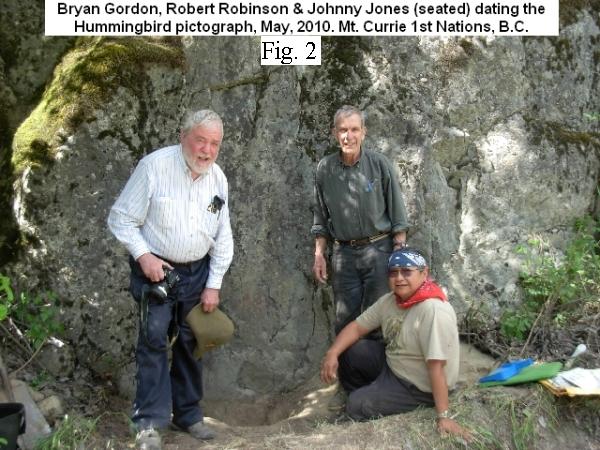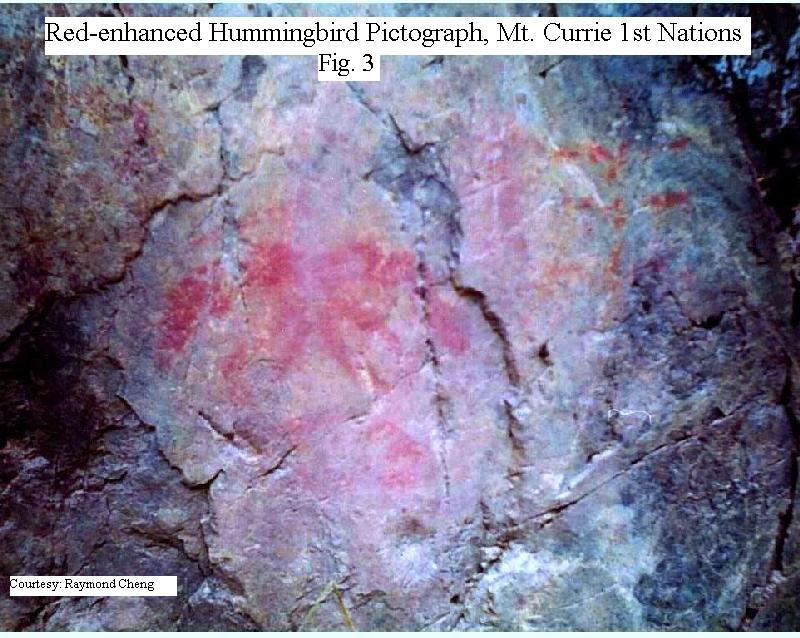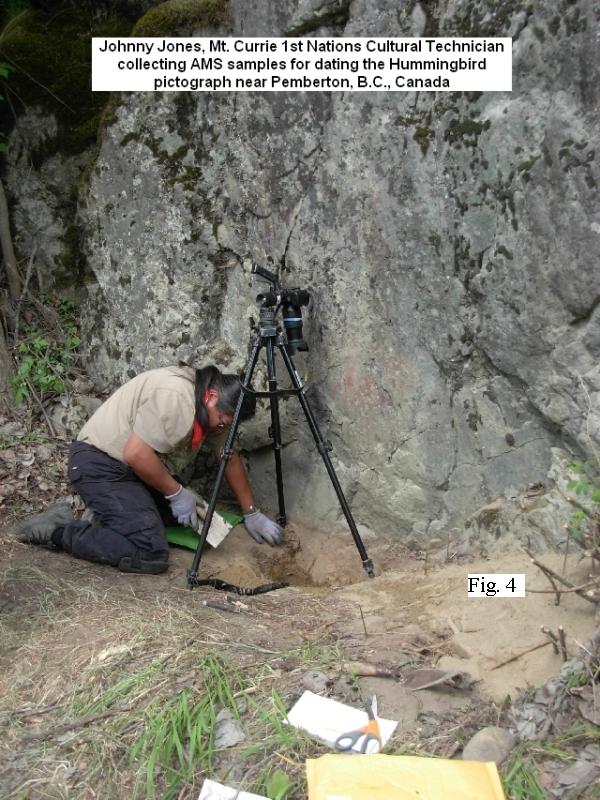On July 1, 2009, we examined the Hummingbird pictograph on Mt. Currie 1st Nations land near
Pemberton, British Columbia (Fig. 1). After finding sufficient soil depth under the pictograph for our dating method, I applied for an archaeological permit. In early May, 2010, we cleared surrounding bushes and tested its levels over two days. The main motif at the cliff bottom interested us most because it was less faded than the others, close to the ground for certain retrieval of paint particles and easily identifiable as a hummingbird, so we red-enhanced it to show details. Our testing team (right to left) consisted of Band cultural technician Johnny Jones, Robert Robinson and Bryan Gordon (Fig. 2), plus Marjory Gordon who took this photo. A close-up of the red-enhanced pictograph shows its out-stretched wings, long narrow beak pointing left, and legs and tail feathers at bottom (Fig. 3). Other motifs at bottom and to the right are unclear, but may include another hummingbird.
We scraped sixty 5 mm levels well into sterile sandy clay, encountering coins left as offerings in the upper late historic levels, yellow-stained mid-level clay in the Proto-Historic period, clay lumps in the Late Prehistoric period and culturally sterile levels at the bottom (Fig. 4). Glue sheets were applied to the surfaces of all levels to collect any red ochre particles to link them to the motif using Scattered Electron Microscopy (SEM). Wood, charcoal, bone or leaf fragments occurred in most levels and were used for Accelerator Mass Spectrometry (AMS) dating. They were collected with tweezers from a sieve and wrapped in aluminium foil after soil or sediment was screened through. The Mt. Currie 1st Nations Band funded an AMS age estimate for level 39 at a depth of 195mm (Table 1). Beta Analytic sent an age estimate of 120.4±0.5 pMC {% modern carbon} years (Beta-283865), adding no problems were encountered. Level 39 had several easily seen probable red ochre particles that were sent for SEM analysis. They show the iron bands of ferric oxide, typical also of red ochre ((Table 2). Their micrometer sized Fe oxide particles on a micaceous chamosite grain appear at 5 millimicrons (Fig. 5). A SEM photo of level 33 which did not have visible ochre shows bright micrometer sized Fe oxides on a variety of mineral grains at 20 millimicrons (Fig. 6). It remains unproven if they are ochre eroded from the art over the past century. Level 39 represents the earliest best-documented painting, but less substantiated data down to level 43 at 215 mm suggest earlier painting. Level 59 at 290mm may be the earliest art, but it consists of one red-orange splatter. So, it is possible that various motifs of the Hummingbird pictograph are prehistoric, as their fading and depth of detritus suggest.
An analysis of Table 1 shows the upper levels down to and including level 13 at 65mm were sterile of red ochre. Upper level sterility was common in pictograph tests elsewhere (see Field Reports, this website). Levels 14 at 70mm, 20 at 100mm, 24 at 120mm, and levels 28 to 30 at 140-150mm, and levels 37 to 38 at 185 and 190mm, likely represent naturally eroded ochre particles that fell after the final painting on the cliff. Below the dated level 39 at 195mm, levels 40 to 41 at 200-205mm appeared sterile of ochre, as did levels 44 to 57 at 220-285mm. Oddly, a red-orange splatter in level 58 at 290mm may be scant evidence of earlier painting, but I gave it a low rating of 2 out of 5 because I was unconvinced that it was red ochre.
Acknowledgements
I thank my crew of Johnny Jones, Robert Robinson and my wife Midge, the Mt. Currie 1st Nations Band for licensing and supporting this fieldwork, Dr. Robert Housley for the SEM results, Raymond Cheng for enhancing the motif and Dr. Frank Bayerl for proof reading.





